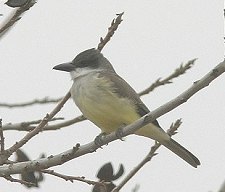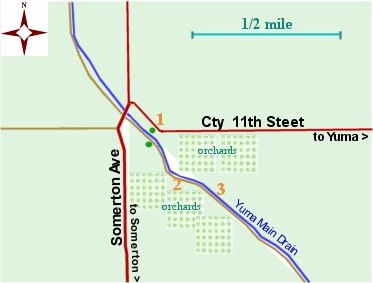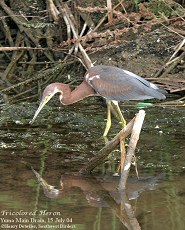DESCRIPTION
The Yuma Main Drain has
hosted a Thick-billed Kingbird from 2002-2005. It usually
shows up at the end of January and leaves at the end of
March. This area is also good for Eurasian Collared-Doves, Osprey, White-tailed Kite,
all the Yuma-area waders, sparrows, and shorebirds. Bird
life here is sometimes a factor of water levels in the
drain--when it's high expect Cinnamon Teal & wintering
waterfow, when it's low expect more waders and shorebirds.
Thick-billed Kingbird
|
DRIVING
DIRECTIONS
Site #1 on the Yuma
County Map
Getting there from the intersection of I-8 and 4th Ave takes
10-20 minutes, depending on traffic:
- drive south on 4th Ave for approximately 2.3 miles to 16th Street
- turn right (west) on 16th Street
- drive west on 16th Street for 1.5 miles to Ave B
- turn left (south) on Ave B
- drive south on Ave B for 2 miles to 32nd Street
- turn right (west) on 32nd Street
- drive west on 32nd Street for approximately 3.4 miles until you reach a 45-degree bend in the road
(32nd Str becomes County 11th Str after you pass Ave D.)
- at this bend in the road (#1 on map below), park on the side of the street
Access the Yuma Main Drain by driving to the intersection of County 11th
Str and Somerton Ave, turning south, crossing the Drain, and parking on the dirt road on the south
side of the Drain.
|
BIRDING
SUGGESTIONS
(Numbered
spots correspond with the map on the right.)
1 ) The Thick-billed Kingbird moves around quite a bit, but makes lots of noise and is pretty reliable at sunset. However, we've seen it all times of the day.
- Walk to the south side of Cty 11th Str and face south. To your right you'll see two large cottonwoods on the other side of a small lateral (canal). We think the kingbird roosts in there for the night. To the left of the cottonwoods, a telephone or electric wire crosses the lateral. The kingbird often flycatches from this wire. In front of the stucco-finished house to your left, look in the pecan tree. Sometimes the bird flycatches from there. But please DO NOT walk in their yard or property. And as you look south, the kingbird may be on the very large cottonwood across the Yuma Main Drain (a big ditch).
2
) A White-tailed Kite has
been hanging out in a lone bush/tree in an alfalfa field nestled
among the orchards. In all the bushes around here check
for Abert's Towhees and various sparrows (mostly Lark &
Savannah).
3
) In the Yuma Main Drain
look for a number of regular winter visitors including Wilson's
Snipe, Greater Yellowlegs, Hooded & Common Mergansers,
waders, and sparrows
|
Yuma
Main Drain

|
Orange
numbers
correspond to birding suggestions on the left
Blue lines are water
Dark green
dots are cottonwood trees
Light
green
dots are orchards |
|
Sightings
since Jan 1, 2005
- (w)
indicates wintering bird
-
(b)
indicates breeding bird
- unusual/rare
birds in red
- Pied-billed Grebe (b)
- Sora
- Hooded & Common Merganser (w)
- Cinnamon Teal (b)
- Great Blue, Green, BC Night Heron (b)
- Great, Cattle, Snowy Egret (b)
- White-faced Ibis
- Greater Yellowlegs (w)
- Long-billed Dowitcher (w)
- Black-necked Stilt
- Wilson's Snipe (w)
- Least Sandpiper (w)
- Western Sandpiper
(w)
- Turkey Vulture
- American Kestrel (b)
-
White-tailed Kite
- Osprey (b along the Co River)
- Peregrine Falcon
- Gambel's Quail (b)
- Eurasian Collared-Dove (b)
- Common Ground-Dove (b)
-
White-winged Dove
(b) (rare in winter)
- Mourning Dove (b)
- Greater Roadrunner (b)
- Anna's Hummingbird (b)
- Belted Kingfisher (w)
- Gila Woodpecker (b)
- Northern Flicker (w)
- Black Phoebe (b)
- Say's Phoebe
-
Thick-billed Kingbird
(w)
- Loggerhead Shrike
- Rough-winged Swallow (b)
- Verdin (b)
- Northern Mockingbird (b)
- Eurasian Starling (b)
- Common Yellowthroat (b)
-Yellow-rumped Warbler (w)
- Great-tailed Grackle (b)
- White-crowned Sparrow (w)
- Red-winged Blackbird (b)
- Lincoln's Sparrow (w)
- Song Sparrow (b)
- Lark Sparrow
- House Sparrow (b)
|
Other
Bird Sightings
During the summer months, look for
these birds, too:
- Western
Kingbird (b)
- Cliff Swallow (b)
And when the cattails have grown up along
the drain (they are periodically poisoned to improve water flow) you'll also
find:
- Least Bittern (b - probably)
- Common Moorhen (b)
- Marsh Wren (b - probably)
- Yellow-headed Blackbird (b)
During migration expect to find the usual complement of warbler, flycatchers,
and other passerines in the fields and trees.

Tricolored Heron
|
|